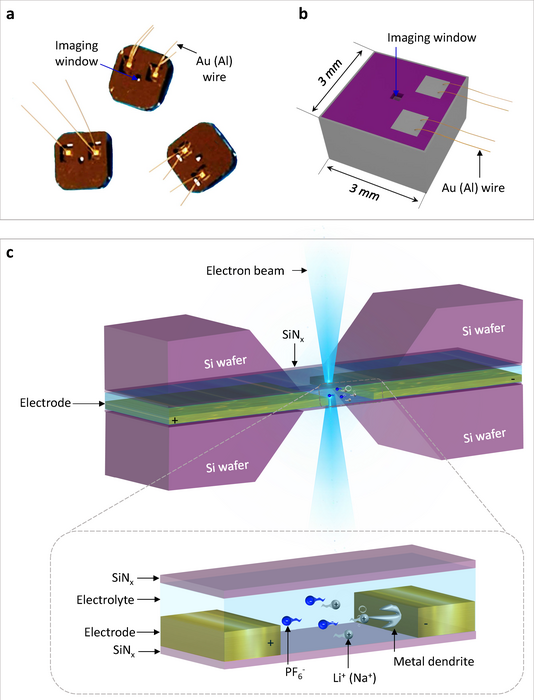In situ observation and recording of important liquid-phase electrochemical reactions in energy devices is crucial for the advancement of energy science. A research team led by a scholar from City University of Hong Kong (CityU) recently developed a novel, tiny device to hold liquid specimens for transmission electron microscopy (TEM) observation, opening the door to directly visualizing and recording complex electrochemical reactions at nanoscale in real-time at high resolution. The research team believes that this innovative method will shed light on strategies for fabricating a powerful research tool for uncovering the mysteries of electrochemical processes in the future.

Credit: © Yang, R. et al. https://www.nature.com/articles/s41596-022-00762-y
In situ observation and recording of important liquid-phase electrochemical reactions in energy devices is crucial for the advancement of energy science. A research team led by a scholar from City University of Hong Kong (CityU) recently developed a novel, tiny device to hold liquid specimens for transmission electron microscopy (TEM) observation, opening the door to directly visualizing and recording complex electrochemical reactions at nanoscale in real-time at high resolution. The research team believes that this innovative method will shed light on strategies for fabricating a powerful research tool for uncovering the mysteries of electrochemical processes in the future.
The use of conventional TEM is limited to thin, stable and solid samples because of the vacuum environment (a vacuum environment prevents the electrons from being absorbed or deflected along their pathways and affecting observation) in the chamber for holding the specimens. Liquid specimens are vacuum-incompatible, so they cannot be directly probed in traditional TEM. Fortunately, with the emergence of the more advanced in-situ “liquid cell TEM”, it is possible to study liquid phase dynamic processes in situ, such as observing crystal nucleation and growth in solution, electrochemical reactions in energy devices, and the life activities of living cells. The “liquid cell” is a core component of TEM to hold the specimens for the electron beam to pass through, thus enabling in-situ observation. But it is challenging to manufacture a high-quality liquid cell for TEM because it involves incorporating electrodes and encapsulating electrolytes in a tiny “closed” liquid cell to prevent leakage and connect it to an external power source at the same time.
A research team co-led by Dr Zeng Zhiyuan, Assistant Professor in the Department of Materials Science and Engineering at CityU, and Professor Li Ju from the Massachusetts Institute of Technology (MIT) successfully developed an efficient and novel method to fabricate “closed” electrochemical liquid cells, which can greatly improve the resolution of TEM with liquid samples.
“The newly developed closed liquid cell performs two main jobs: (1) enclosing the liquid samples in a closed container, thereby separating them from the microscope vacuum environment; and (2) confining the liquid samples to a thin enough liquid layer using two electron-transparent silicon nitride (SiNx) windows, so that electrons can travel through the liquid layer and image the reactions,” explained Dr Zeng.
To manufacture the high-performance, “closed” electrochemical liquid cells in this protocol, the research team used advanced nanofabrication techniques, including photolithography, to fabricate the core component of in situ liquid TEM – the liquid cell. Photolithography is a process that uses ultraviolet light to transfer a geometric design from an optical mask to a light-sensitive chemical (photoresist) coated on the substrate.
The team fabricated the bottom chip and top chip separately, and then assembled them together. Gold or titanium electrodes were deposited on the bottom chip during the metal deposition process. Then the electrolyte was loaded and sealed inside the liquid cell.
Using this innovative liquid cell with the transmission electron microscope, the dynamic electrochemical reactions of the liquid sample on the electrode surface can be recorded in real time at high resolution through the TEM operating system incorporated with a high spatio-temporal resolution camera.
“The electrochemical liquid cell designed by our customized nanofabrication method has thinner SiNx imaging windows (35nm) than commercial ones (50nm),” explained Dr Zeng. “It also has a thinner liquid layer (150nm) than that of commercial ones (1,000 nm). The thinner SiNx imaging windows and thinner liquid layer ensure that our fabricated liquid cell can capture electrochemical reactions with better TEM spatial resolution than commercial ones can.”
The team believes that a lot of opportunities and applications for the in-situ TEM observation of electrochemical reactions will emerge soon after the development of the electrochemical liquid cell with the selection of patterned metal electrodes and the encapsulated liquid electrolytes in the liquid cell.
This newly proposed fabrication protocol can also be utilized in other in-situ techniques beyond TEM. For example, a proper adjustment to this protocol would be suitable for the fabrication of electrochemical liquid cells for in-situ X-ray characterizations of electrochemical reactions (X-ray absorption spectroscopy, X-ray diffraction, etc.).
The findings were published in the scientific journal Nature Protocols, titled “Fabrication of Liquid Cell for In-Situ Transmission Electron Microscopy of Electrochemical Processes”.
Dr Zeng, from CityU, and Professor Li, from MIT, are the corresponding authors of the paper. The first author is Mr Yang Ruijie, from Dr Zeng’s research group. Other collaborators are from Xiamen University and Xi’an Jiaotong University.
The work was supported by the Hong Kong Research Grants Council and the Shenzhen Science and Technology Innovation Committee.
https://www.cityu.edu.hk/research/stories/2023/02/12/cityu-researchers-invented-novel-device-enabling-high-resolution-observation-liquid-phase-dynamic-processes-nanoscale
Journal
Nature Protocols
DOI
10.1038/s41596-022-00762-y
Method of Research
Experimental study
Article Title
Fabrication of liquid cell for in situ transmission electron microscopy of electrochemical processes
Article Publication Date
4-Nov-2022




